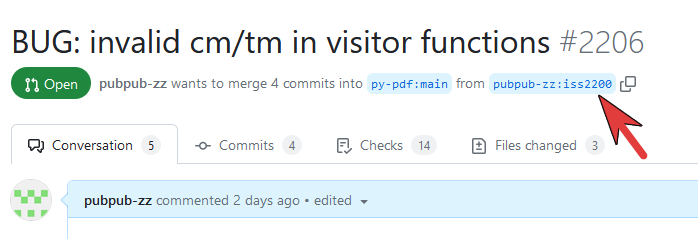Testing
pypdf uses pytest for testing.
To run the tests you need to install the CI (Continuous Integration) requirements by running pip install -r requirements/ci.txt or
pip install -r requirements/ci-3.11.txt if running python 3.11.
De-selecting groups of tests
pypdf makes use of the following pytest markers:
slow: Tests that require more than 5 secondssamples: Tests that require the thesample-filesgit submodule to be initialized. As of October 2022, this is about 25 MB.enable_socket: Tests that download PDF documents. They are stored locally and thus only need to be downloaded once. As of October 2022, this is about 200 MB.
You can disable them by pytest -m "not enable_socket" or pytest -m "not samples".
You can even disable all of them: pytest -m "not enable_socket" -m "not samples" -m "not slow".
Please note that this reduces test coverage. The CI will always test all files.
Creating a Coverage Report
If you want to get a coverage report that considers the Python version specific
code, you can run tox.
As a prerequisite, we recommend using pyenv
so that you can install the different Python versions:
pyenv install pypy3.8-7.3.7
pyenv install 3.6.15
pyenv install 3.7.12
pyenv install 3.8.12
pyenv install 3.9.10
pyenv install 3.10.2
Then you can execute tox which will create a coverage report in HTML form
in the end. The execution takes about 30 minutes.
Docstrings in Unit tests
The first line of a docstring in a unit test should be written in a way that you could prefix it with “This tests ensures that …”, e.g.
Invalid XML in xmp_metadata is gracefully handled.
The identity is returning its input.
xmp_modify_date is extracted correctly.
This way, plugins like pytest-testdox
can generate really nice output when the tests are running. This looks similar
to the output of mocha.js.
If the test is a regression test, write
This test is a regression test for issue #1234
If the regression test is just one parameter of other tests, then add it as a comment for that parameter.
Evaluate a PR in-progress version
You may want to test a version from a PR which has not been released yet. The easiest way is to use pip and install a version from git:
a) Go the PR and identify the repository and branch.
Example from below : repository: pubpub-zz / branch: iss2200 :

b) you can then install the version using pip from git:
Example:
pip install git+https://github.com/pubpub-zz/pypdf.git@iss2200